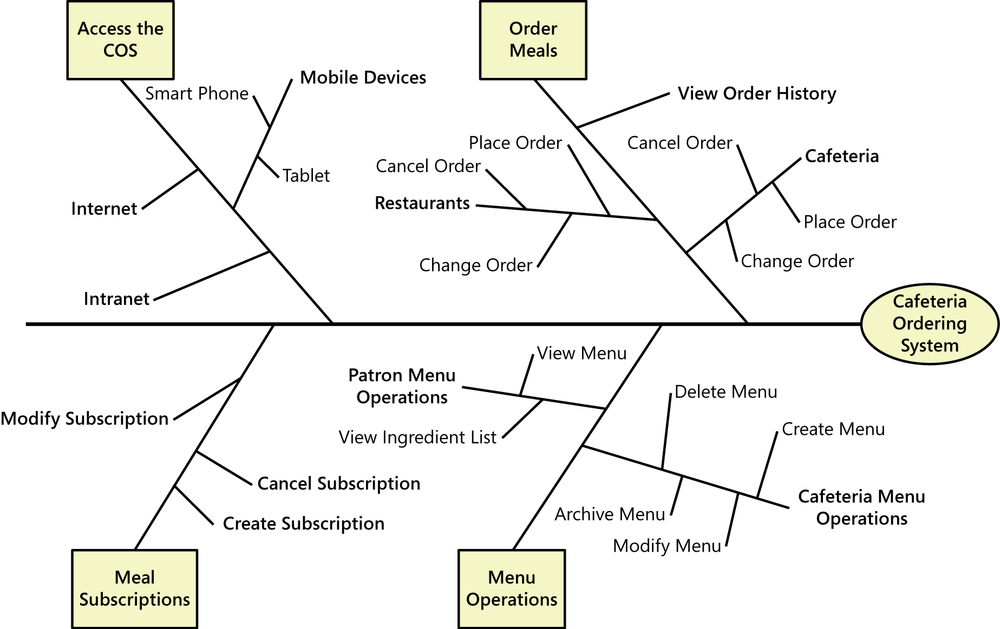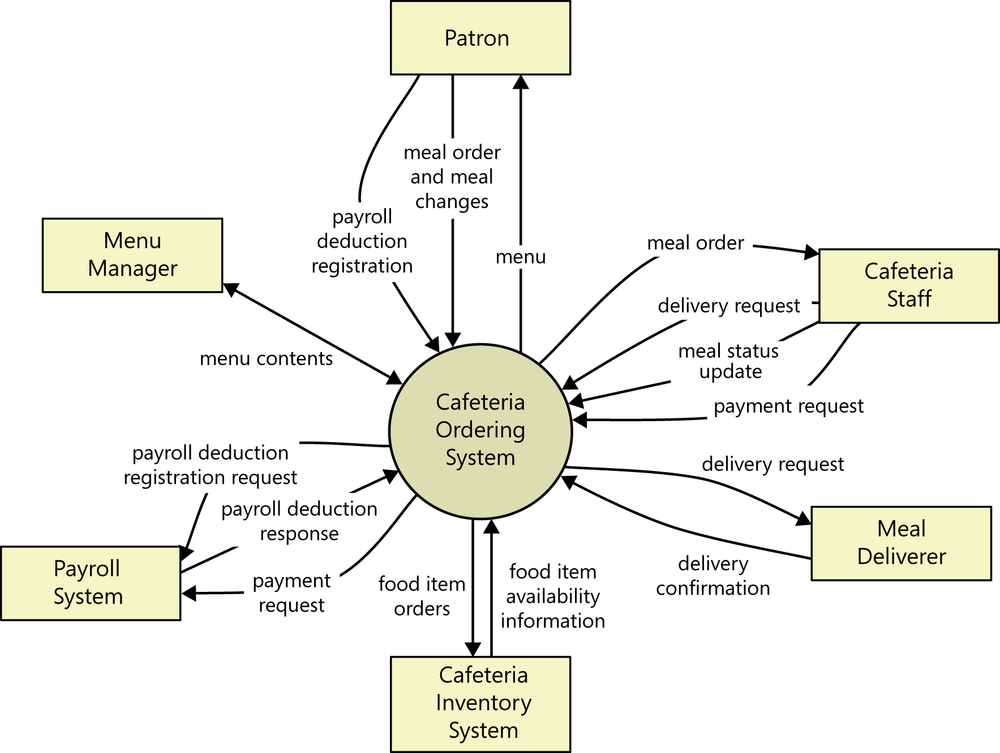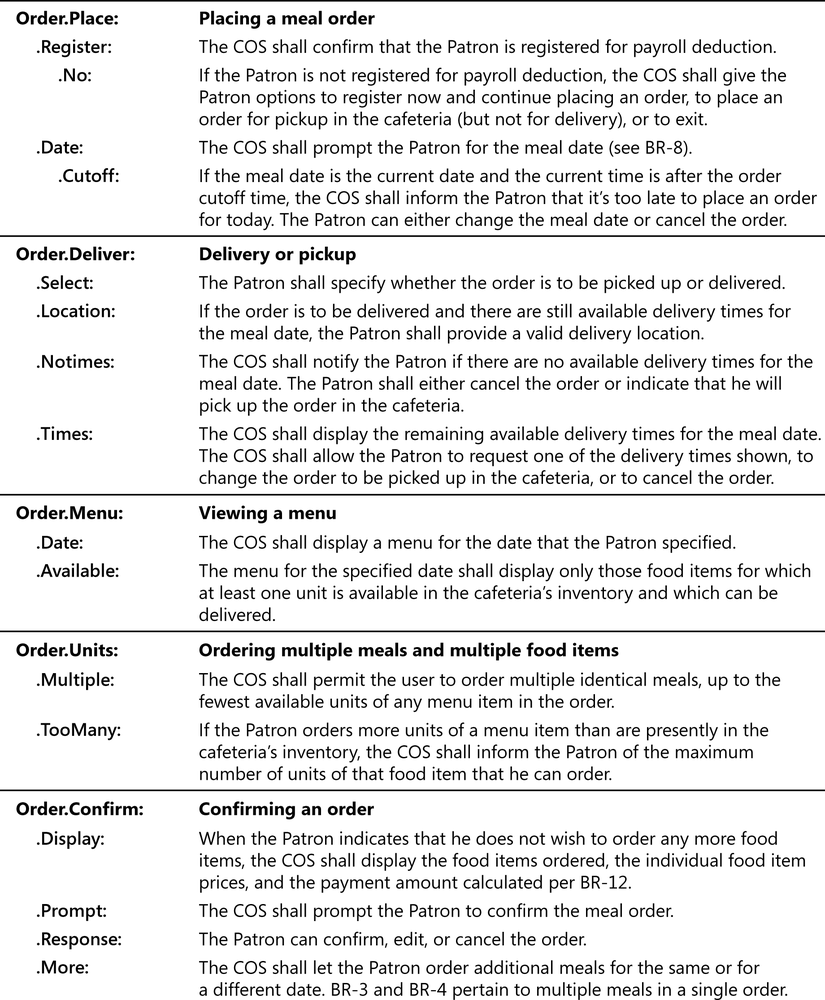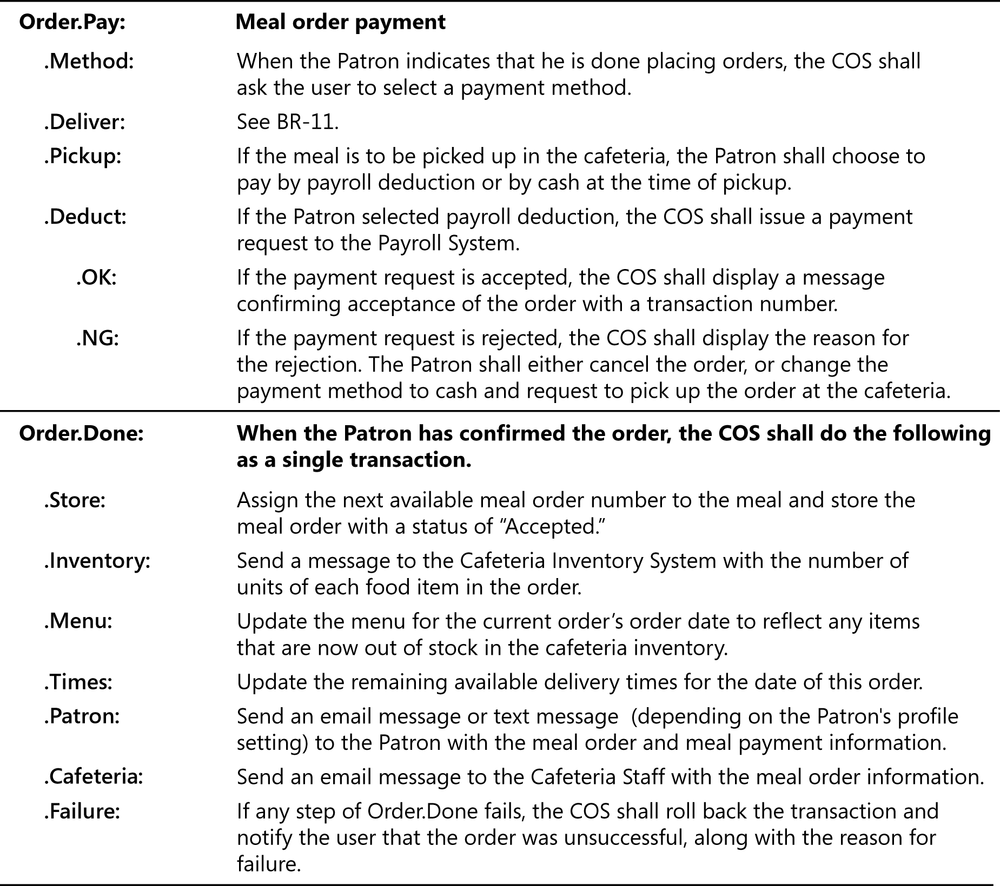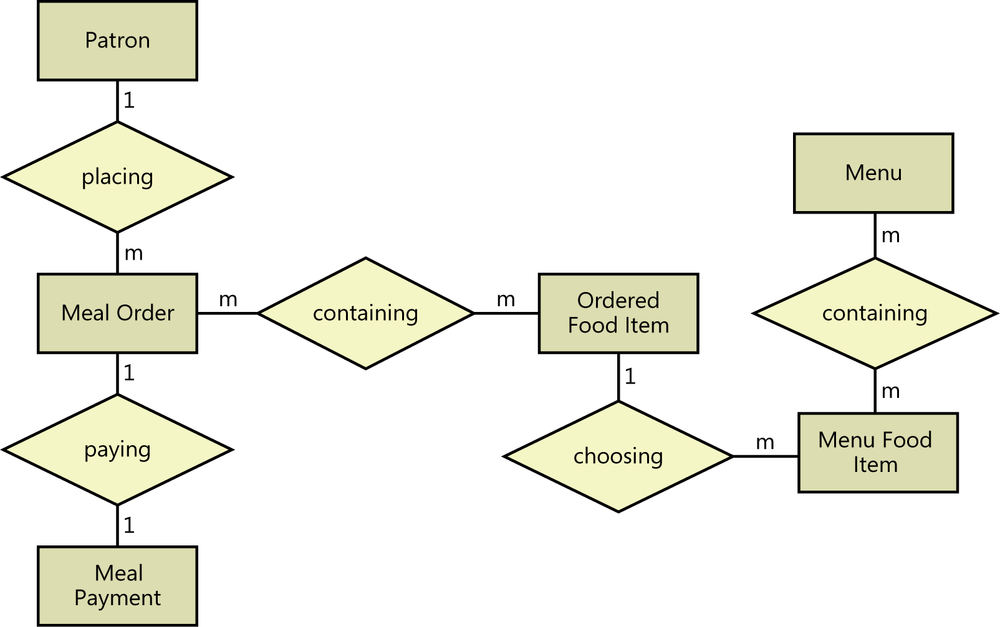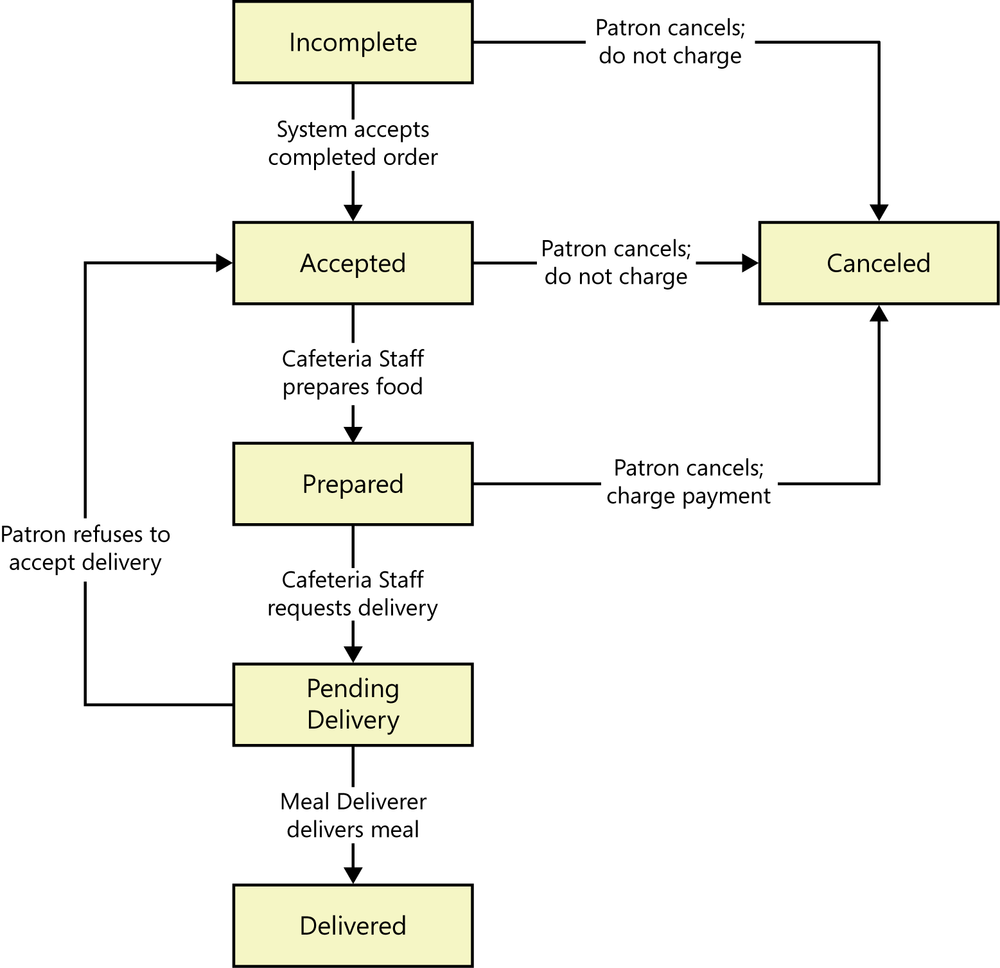Appendix D. Sample requirements documents
This appendix illustrates some of the requirements documents and diagrams described in this book, using a hypothetical project called the Cafeteria Ordering System (COS). This appendix includes:
A vision and scope document.
A list of use cases and several use case specifications, showing different degrees of detail.
A portion of a software requirements specification.
Several partial analysis models, including a feature tree, context diagram, entity-relationship diagram, and state-transition diagram.
A partial data dictionary.
Several business rules.
Because this is just an example, these deliverables aren’t intended to be complete. Instead, they are meant to illustrate how the various types of requirements information relate to each other and how you might write the contents of each document section. The information in these examples could be organized and grouped in many other reasonable ways, including combining it into a single document on a small project or storing it in a requirements management tool. Clarity, completeness, and usability of the requirements information are the essential objectives. The examples conform to the templates described in previous chapters. Because this is a small project, some template sections have been combined. Every project should consider how to adapt the organization’s standard templates to best suit the size and nature of the project.
Vision and Scope Document
1. Business Requirements
1.1 Background
Employees at the company Process Impact presently spend an average of 65 minutes per day going to the cafeteria to select, purchase, and eat lunch. About 20 minutes of this time is spent walking to and from the cafeteria, selecting their meals, and paying by cash or credit card. When employees go out for lunch, they spend an average of 90 minutes off-site. Some employees phone the cafeteria in advance to order a meal to be ready for them to pick up. Employees don’t always get the selections they want because the cafeteria runs out of certain items. The cafeteria wastes a significant quantity of food that is not purchased and must be thrown away. These same issues apply to breakfast and supper, although far fewer employees use the cafeteria for those meals than for lunch.
1.2 Business Opportunity
Many employees have requested a system that would permit a cafeteria user to order meals (defined as a set of one or more food items selected from the cafeteria menu) online, to be picked up at the cafeteria or delivered to a company location at a specified time and date. Such a system would save employees time, and it would increase their chance of getting the items they prefer. Knowing what food items customers want in advance would reduce waste in the cafeteria and would improve the efficiency of cafeteria staff. The future ability for employees to order meals for delivery from local restaurants would make a wide range of choices available to employees and provide the possibility of cost savings through volume discount agreements with the restaurants.
1.3 Business Objectives
BO-1: Reduce the cost of cafeteria food wastage by 40% within 6 months following initial release. [This example shows the use of Planguage to precisely state a business objective.]
Scale: Cost of food thrown away each week by cafeteria staff
Meter: Examination of Cafeteria Inventory System logs
Past: 33% (2013, initial study)
Goal: Less than 20%
Stretch: Less than 15%
BO-2: Reduce cafeteria operating costs by 15% within 12 months following initial release.
BO-3: Increase average effective work time by 15 minutes per cafeteria-using employee per day within 6 months following initial release.
1.4 Success Metrics
SM-1: 75% of employees who used the cafeteria at least 3 times per week during Q3 2013 use the COS at least once a week within 6 months following initial release.
SM-2: The average rating on the quarterly cafeteria satisfaction survey increases by 0.5 on a scale of 1 to 6 from the Q3 2013 rating within 3 months following initial release and by 1.0 within 12 months.
1.5 Vision Statement
For employees who want to order meals from the company cafeteria or from local restaurants online, the Cafeteria Ordering System is an Internet-based and smartphone-enabled application that will accept individual or group meal orders, process payments, and trigger delivery of the prepared meals to a designated location on the Process Impact campus. Unlike the current telephone and manual ordering processes, employees who use the Cafeteria Ordering System will not have to go to the cafeteria to get their meals, which will save them time and will increase the food choices available to them.
1.6 Business Risks
RI-1: The Cafeteria Employees Union might require that their contract be renegotiated to reflect the new employee roles and cafeteria hours of operation. (Probability = 0.6; Impact = 3)
RI-2: Too few employees might use the system, reducing the return on investment from the system development and the changes in cafeteria operating procedures. (Probability = 0.3; Impact = 9)
RI-3: Local restaurants might not agree to offer delivery, which would reduce employee satisfaction with the system and possibly their usage of it. (Probability = 0.3; Impact = 3)
RI-4: Sufficient delivery capacity might not be available, which means that employees might not always receive their meals on time and could not always request delivery for the desired times. (Probability = 0.5; Impact = 6)
1.7 Business Assumptions and Dependencies
AS-1: Systems with appropriate user interfaces will be available for cafeteria employees to process the expected volume of meals ordered.
AS-2: Cafeteria staff and vehicles will be available to deliver all meals for specified delivery time slots within 15 minutes of the requested delivery time.
DE-1: If a restaurant has its own online ordering system, the Cafeteria Ordering System must be able to communicate with it bidirectionally.
2. Scope and Limitations
2.1 Major Features
FE-1: Order and pay for meals from the cafeteria menu to be picked up or delivered.
FE-2: Order and pay for meals from local restaurants to be delivered.
FE-3: Create, view, modify, and cancel meal subscriptions for standing or recurring meal orders, or for daily special meals.
FE-4: Create, view, modify, delete, and archive cafeteria menus.
FE-5: View ingredient lists and nutritional information for cafeteria menu items.
FE-6: Provide system access through corporate intranet, smartphone, tablet, and outside Internet access by authorized employees.
2.2 Scope of Initial and Subsequent Releases
Feature | Release 1 | Release 2 | Release 3 |
FE-1, Order from cafeteria | Standard meals from lunch menu only; meal orders for delivery can be paid for by payroll deduction only | Accept credit and debit card payments | Accept meal orders for breakfasts and suppers |
FE-2, Order from restaurants | Not implemented | Delivery to campus locations only | Fully implemented |
FE-3, Meal subscriptions | Not implemented | Implemented if time permits | Fully implemented |
FE-4, Menus | Create and view menus | Modify, delete, and archive menus | |
FE-5, Ingredient lists | Not implemented | Fully implemented | |
FE-6, System access | Intranet and outside Internet access | iOS and Android phone and tablet apps | Windows Phone and tablet apps |
2.3 Limitations and Exclusions
LI-1: Some food items that are available from the cafeteria will not be suitable for delivery, so the delivery menus available to patrons of the COS must be a subset of the full cafeteria menus.
LI-2: The COS shall be used only for the cafeteria at the Process Impact campus in Clackamas, Oregon.
3. Business Context
3.1 Stakeholder Profiles
Stakeholder | Major value | Attitudes | Major interests | Constraints |
Corporate Management | Improved employee productivity; cost savings for cafeteria | Strong commitment through release 2; support for release 3 contingent on earlier results | Cost and employee time savings must exceed development and usage costs | None identified |
Cafeteria Staff | More efficient use of staff time throughout the day; higher customer satisfaction | Concern about union relationships and possible downsizing; otherwise receptive | Job preservation | Training for staff in Internet usage needed; delivery staff and vehicles needed |
Patrons | Better food selection; time savings; convenience | Strong enthusiasm, but might not use it as much as expected because of social value of eating lunches in cafeteria and restaurants | Simplicity of use; reliability of delivery; availability of food choices | Corporate intranet access, Internet access, or a mobile device is needed |
Payroll Department | No benefit; needs to set up payroll deduction registration scheme | Not happy about the software work needed, but recognizes the value to the company and employees | Minimal changes in current payroll applications | No resources yet committed to make software changes |
Increased sales; marketing exposure to generate new customers | Receptive but cautious | Minimal new technology needed; concern about resources and costs of delivering meals | Might not have capacity to handle order levels; might not all have menus online |
3.2 Project Priorities
Dimension | Constraint | Driver | Degree of freedom |
Features | All features scheduled for release 1.0 must be fully operational | ||
Quality | 95% of user acceptance tests must pass; all security tests must pass | ||
Schedule | Release 1 planned to be available by end of Q1 of next year, release 2 by end of Q2; overrun of up to 2 weeks acceptable without sponsor review | ||
Cost | Budget overrun up to 15% acceptable without sponsor review | ||
Staff | Team size is half-time project manager, half-time BA, 3 developers, and 1 tester; additional developer and half-time tester available if necessary |
3.3 Deployment Considerations
The web server software will need to be upgraded to the latest version. Apps will have to be developed for iOS and Android smartphones and tablets as part of the second release, with corresponding apps for Windows Phone and tablets to follow for the third release. Any corresponding infrastructure changes must be in place at the time of the second release. Videos no more than five minutes in length shall be developed to train users in both the Internet-based and app-based versions of COS.
Use Cases
The various user classes identified the following primary actors and use cases for the COS:
Primary actor | Use cases |
Patron | 1. Order a Meal 2. Change Meal Order 3. Cancel Meal Order 4. View Menu 5. Register for Payroll Deduction 6. Unregister for Payroll Deduction 7. Manage Meal Subscription |
Menu Manager | 8. Create a Menu 9. Modify a Menu 10. Delete a Menu 11. Archive Menus 12. Define a Meal Special |
Cafeteria Staff | 13. Prepare Meal 14. Generate a Payment Request 15. Request Meal Delivery 16. Generate System Usage Reports |
Meal Deliverer | 17. Record Meal Delivery 18. Print Delivery Instructions |
ID and Name: | UC-1: Order a Meal | ||
Created By: | Prithvi Raj | Date Created: | October 4, 2013 |
Primary Actor: | Patron | Secondary Actors: | Cafeteria Inventory System |
Description: | A Patron accesses the Cafeteria Ordering System from either the corporate intranet or external Internet, views the menu for a specific date, selects food items, and places an order for a meal to be picked up in the cafeteria or delivered to a specified location within a specified 15-minute time window. | ||
Trigger: | A Patron indicates that he wants to order a meal. | ||
Preconditions: | PRE-1. Patron is logged into COS. PRE-2. Patron is registered for meal payments by payroll deduction. | ||
Postconditions: | POST-1. Meal order is stored in COS with a status of “Accepted.” POST-2. Inventory of available food items is updated to reflect items in this order. POST-3. Remaining delivery capacity for the requested time window is updated. | ||
Normal Flow: | 1.0 Order a Single Meal
| ||
Alternative Flows: | 1.1 Order multiple identical meals
1.2 Order multiple meals
| ||
Exceptions: | 1.0.E1 Requested date is today and current time is after today’s order cutoff time 1. COS informs Patron that it’s too late to place an order for today. 2a. If Patron cancels the meal ordering process, then COS terminates use case. 2b. Else if Patron requests another date, then COS restarts use case. 1.0.E2 No delivery times left 1. COS informs Patron that no delivery times are available for the meal date. 2a. If Patron cancels the meal ordering process, then COS terminates use case. 2b. Else if Patron requests to pick the order up at the cafeteria, then continue with normal flow, but skip steps 7 and 8. 1.1.E1 Insufficient inventory to fulfill multiple meal order 1. COS informs Patron of the maximum number of identical meals he can order, based on current available inventory. 2a. If Patron modifies number of meals ordered, then return to step 4 of normal flow. 2b. Else if Patron cancels the meal ordering process, then COS terminates use case. | ||
Priority: | High | ||
Frequency of Use: | Approximately 300 users, average of one usage per day. Peak usage load for this use case is between 9:00 A.M. and 10:00 A.M. local time. | ||
Business Rules: | BR-1, BR-2, BR-3, BR-4, BR-11, BR-12, BR-33 | ||
Other Information: |
| ||
Assumptions: | Assume that 15 percent of Patrons will order the daily special (Source: previous 6 months of cafeteria data). | ||
[Note: the following use case is written in less detail than UC-1, to illustrate that it isn’t always necessary to fully specify every detail of the use case, provided developers have the necessary information available from some other source.]
ID and Name: | UC-5 Register for Payroll Deduction | ||
Created By: | Nancy Anderson | Date Created: | September 15, 2013 |
Primary Actor: | Patron | Secondary Actors: | Payroll System |
Description: | Cafeteria patrons who use the COS and have meals delivered must be registered for payroll deduction. For noncash purchases made through the COS, the cafeteria will issue a payment request to the Payroll System, which will deduct the meal costs from the next scheduled employee payday direct deposit. | ||
Trigger: | Patron requests to register for payroll deduction, or Patron says yes when COS asks if he wants to register. | ||
Preconditions: | PRE-1. Patron is logged into COS. | ||
Postconditions: | POST-1. Patron is registered for payroll deduction. | ||
Normal Flow: | 5.0 Register for Payroll Deduction
| ||
Alternative Flows: | None | ||
Exceptions: | 5.0.E1 Patron is not eligible for payroll deduction. 5.0.E2 Patron is already enrolled for payroll deduction. | ||
Priority: | High | ||
Business Rules: | BR-86 and BR-88 govern an employee’s eligibility to enroll for payroll deduction. | ||
Other Information: | Expect high frequency of executing this use case within first 2 weeks after system is released. | ||
[Note: the following use case is written in a very brief form, to illustrate that it is not always necessary to fully complete the use case template, provided developers have the necessary information available from some other source. It’s a good idea to plan out which use cases require detailing and which do not.]
ID and Name: | UC-9 Modify a Menu | ||
Created By: | Mark Hassall | Date Created: | October 7, 2013 |
Description: | The cafeteria Menu Manager may retrieve the menu for a specific date in the future, modify it to add new food items, remove or change food items, create or change a meal special, or change prices, and save the modified menu. | ||
Exceptions: | No menu exists for the specified date; show an error message and let the Menu Manager enter a new date. | ||
Priority: | High | ||
Business Rules: | BR-24 | ||
Other Information: | Certain food items will not be deliverable, so the menu presented to the Patrons of the COS for delivery will not always exactly match the menu available for pickup in the cafeteria. The Menu Manager can set which items are not deliverable. | ||
Software Requirements Specification
1. Introduction
1.1 Purpose
This SRS describes the functional and nonfunctional requirements for software release 1.0 of the Cafeteria Ordering System (COS). This document is intended to be used by the members of the project team who will implement and verify the correct functioning of the system. Unless otherwise noted, all requirements specified here are committed for release 1.0.
1.2 Document Conventions
No special typographical conventions are used in this SRS.
1.3 Project Scope
The COS will permit Process Impact employees to order meals from the company cafeteria online to be delivered to specified campus locations. A detailed description is available in the Cafeteria Ordering System Vision and Scope Document [1], along with the features that are scheduled for full or partial implementation in this release.
1.4 References
Wiegers, Karl. Cafeteria Ordering System Vision and Scope Document, www.processimpact.com/projects/COS/COS Vision and Scope.docx
Beatty, Joy. Process Impact Intranet Development Standard, Version 1.3, www.processimpact.com/corporate/standards/PI Intranet Development Standard.pdf
Rath, Andrew. Process Impact Internet Application User Interface Standard, Version 2.0, www.processimpact.com/corporate/standards/PI Internet UI Standard.pdf
2. Overall Description
2.1 Product Perspective
The Cafeteria Ordering System is a new software system that replaces the current manual and telephone processes for ordering and picking up meals in the Process Impact cafeteria. The context diagram in Figure D-2 illustrates the external entities and system interfaces for release 1.0. The system is expected to evolve over several releases, ultimately connecting to the Internet ordering services for several local restaurants and to credit and debit card authorization services.
2.2 User Classes and Characteristics
User class | Description |
Patron (favored) | A Patron is a Process Impact employee who wants to order meals to be delivered from the company cafeteria. There are about 600 potential Patrons, of which 300 are expected to use the COS an average of 5 times per week each. Patrons will sometimes order multiple meals for group events or guests. An estimated 60 percent of orders will be placed using the corporate intranet, with 40 percent of orders being placed from home or by smartphone or tablet apps. |
Cafeteria Staff | The Process Impact cafeteria employs about 20 Cafeteria Staff who will receive orders from the COS, prepare meals, package them for delivery, and request delivery. Most of the Cafeteria Staff will need training in the use of the hardware and software for the COS. |
Menu Manager | The Menu Manager is a cafeteria employee who establishes and maintains daily menus of the food items available from the cafeteria. Some menu items may not be available for delivery. The Menu Manager will also define the cafeteria’s daily specials. The Menu Manager will need to edit existing menus periodically. |
Meal Deliverer | As the Cafeteria Staff prepare orders for delivery, they will issue delivery requests to a Meal Deliverer’s smartphone. The Meal Deliverer will pick up the food and deliver it to the Patron. A Meal Deliverer’s other interactions with the COS will be to confirm that a meal was (or was not) delivered. |
2.3 Operating Environment
OE-1: The COS shall operate correctly with the following web browsers: Windows Internet Explorer versions 7, 8, and 9; Firefox versions 12 through 26; Google Chrome (all versions); and Apple Safari versions 4.0 through 8.0.
OE-2: The COS shall operate on a server running the current corporate-approved versions of Red Hat Linux and Apache HTTP Server.
OE-3: The COS shall permit user access from the corporate intranet; from a VPN Internet connection; and by Android, iOS, and Windows smartphones and tablets.
2.4 Design and Implementation Constraints
CO-1: The system’s design, code, and maintenance documentation shall conform to the Process Impact Intranet Development Standard, Version 1.3 [2].
CO-2: The system shall use the current corporate standard Oracle database engine.
CO-3: All HTML code shall conform to the HTML 5.0 standard.
2.5 Assumptions and Dependencies
AS-1: The cafeteria is open for breakfast, lunch, and supper every company business day in which employees are expected to be on site.
DE-1: The operation of the COS depends on changes being made in the Payroll System to accept payment requests for meals ordered with the COS.
DE-2: The operation of the COS depends on changes being made in the Cafeteria Inventory System to update the availability of food items as COS accepts meal orders.
3. System Features
3.1 Order Meals from Cafeteria
3.1.1 Description
A cafeteria Patron whose identity has been verified can order meals either to be delivered to a specified company location or to be picked up in the cafeteria. A Patron can cancel or change a meal order if it has not yet been prepared. Priority = High.
3.2 Order Meals from Restaurants
[Details are not provided in this example. Quite a lot of the functionality described under 3.1 Order Meals from Cafeteria could likely be reused, so this section should just specify the additional functionality that addresses the restaurant interface.]
3.3 Create, View, Modify, and Delete Meal Subscriptions
[Details are not provided in this example.]
3.4 Create, View, Modify, and Delete Cafeteria Menus
[Details are not provided in this example.]
4. Data Requirements
4.1 Logical Data Model
4.2 Data Dictionary
Description | Composition or data type | Length | Values | |
delivery instruction | where and to whom a meal is to be delivered, if it isn’t being picked up in the cafeteria | patron name + patron phone number + meal date + delivery location + delivery time window | ||
delivery location | building and room to which an ordered meal is to be delivered | alphanumeric | 50 | hyphens and commas permitted |
delivery time window | beginning time of a 15-minute range on the meal date during which an ordered meal is to be delivered | time | hh:mm | local time; hh = 0-23 inclusive; mm = 00, 15, 30, or 45 |
employee ID | company ID number of the employee who placed a meal order | integer | 6 | |
food item description | description of a food item on a menu | alphabetic | 100 | |
food item price | pre-tax cost of a single unit of a menu food item | numeric, dollars and cents | dd.cc | |
meal date | the date the meal is to be delivered or picked up | date, MM/DD/YYYY | 10 | default = current date if the current time is before the order cutoff time, else the next day; cannot be prior to current date |
meal order | details about a meal a Patron ordered | meal order number + order date + meal date + 1:m{ordered food item} + delivery instruction + meal order status | ||
meal order number | unique ID that COS assigns to each accepted meal order | integer | 7 | Initial value is 1 |
meal order status | status of a meal order that a Patron initiated | alphabetic | 16 | Incomplete, accepted, prepared, pending delivery, delivered, canceled |
meal payment | information about a payment COS accepted for a meal | payment amount + payment method + transaction number | ||
menu | list of food items available for purchase on a specific date | menu date + 1:m{menu food item} | ||
menu date | the date for which a specific menu is available | date, MM/DD/YYYY | 10 | |
menu food item | description of a menu item | food item description + food item price | ||
order cutoff time | the time of day before which all meal orders for that date must be placed | time, HH:MM | 5 | |
order date | the date on which a Patron placed a meal order | date, MM/DD/YYYY | 10 | |
ordered food item | one menu food item that a Patron requested as part of a meal order | menu food item + quantity ordered | ||
patron | a Process Impact employee who is authorized to order a meal | patron name + employee ID + patron phone number + patron location + patron email | ||
patron email | email address of the employee who placed a meal order | alphanumeric | 50 | |
patron location | building and room numbers of the employee who placed a meal order | alphanumeric | 50 | hyphens and commas permitted |
patron name | name of the employee who placed a meal order | alphabetic | 30 | |
patron phone number | telephone number of the employee who placed a meal order | AAA-EEE-NNNN xXXXX for area code (A), exchange (E), number (N), and extension (X) | 18 | |
total price of an order in dollars and cents, calculated per BR-12 | numeric, dollars and cents | dddd.cc | ||
payment method | how the Patron is paying for a meal he ordered | alphabetic | 16 | payroll deduction, cash, credit card, debit card |
quantity ordered | the number of units of each food item that the Patron is ordering in a single meal order | integer | 4 | default = 1; maximum = quantity presently in inventory |
transaction number | unique sequence number that COS assigns to each payment transaction | integer | 12 |
4.3 Reports
4.3.1 Ordered Meal History Report
Report ID | COS-RPT-1 |
Report Title | Ordered Meal History |
Report Purpose | Patron wants to see a list of all meals that he had previously ordered from the Process Impact cafeteria or local restaurants over a specified time period up to 6 months prior to the current date, so he can reorder a particular meal he liked. |
Priority | Medium |
Report Users | Patrons |
Data Sources | Database of previously placed meal orders |
Frequency and Disposition | Report is generated on demand by a Patron. Data in the report is static. Report is displayed on user’s web browser screen on a computer, tablet, or smartphone. It can be printed if the display device permits printing. |
Latency | Complete report must be displayed to Patron within 3 seconds after it is requested. |
Visual Layout | Landscape mode |
Header and Footer | Report header shall contain the report title, Patron’s name, and date range specified. If printed, report footer shall show the page number. |
Report Body | Fields shown and column headings:
Selection Criteria: date range specified by Patron, inclusive of end points Sort Criteria: reverse chronological order |
End-of-Report Indicator | None |
Interactivity | Patron can drill down to see ingredients and nutritional information for each item in the order. |
Security Access Restrictions | A Patron may retrieve only his own meal order history. |
[Note: Other COS reports are not provided in this example.]
5. External Interface Requirements
5.1 User Interfaces
UI-1: The Cafeteria Ordering System screen displays shall conform to the Process Impact Internet Application User Interface Standard, Version 2.0 [3].
UI-2: The system shall provide a help link from each displayed webpage to explain how to use that page.
UI-3: The webpages shall permit complete navigation and food item selection by using the keyboard alone, in addition to using mouse and keyboard combinations.
5.2 Software Interfaces
SI-1: Cafeteria Inventory System
SI-1.1: The COS shall transmit the quantities of food items ordered to the Cafeteria Inventory System through a programmatic interface.
SI-1.2: The COS shall poll the Cafeteria Inventory System to determine whether a requested food item is available.
SI-1.3: When the Cafeteria Inventory System notifies the COS that a specific food item is no longer available, the COS shall remove that food item from the menu for the current date.
SI-2: Payroll System
The COS shall communicate with the Payroll System through a programmatic interface for the following operations:
SI-2.1: To allow a Patron to register and unregister for payroll deduction.
SI-2.2: To inquire whether a Patron is registered for payroll deduction.
SI-2.3: To inquire whether a Patron is eligible to register for payroll deduction.
SI-2.4: To submit a payment request for a purchased meal.
SI-2.5: To reverse a previous charge because a patron rejected a meal or wasn’t satisfied with it, or because the meal was not delivered per the delivery instructions.
5.3 Hardware Interfaces
No hardware interfaces have been identified.
5.4 Communications Interfaces
CI-1: The COS shall send an email or text message (based on user account settings) to the Patron to confirm acceptance of an order, price, and delivery instructions.
CI-2: The COS shall send an email or text message (based on user account settings) to the Patron to report any problems with a meal order or delivery.
6. Quality Attributes
6.1 Usability Requirements
USE-1: The COS shall allow a Patron to retrieve the previous meal ordered with a single interaction.
USE-2: 95% of new users shall be able to successfully order a meal without errors on their first try.
6.2 Performance Requirements
PER-1: The system shall accommodate a total of 400 users and a maximum of 100 concurrent users during the peak usage time window of 9:00 A.M. to 10:00 A.M. local time, with an estimated average session duration of 8 minutes.
PER-2: 95% of webpages generated by the COS shall download completely within 4 seconds from the time the user requests the page over a 20 Mbps or faster Internet connection.
PER-3: The system shall display confirmation messages to users within an average of 3 seconds and a maximum of 6 seconds after the user submits information to the system.
6.3 Security Requirements
SEC-1: All network transactions that involve financial information or personally identifiable information shall be encrypted per BR-33.
SEC-2: Users shall be required to log on to the COS for all operations except viewing a menu.
SEC-3: Only authorized Menu Managers shall be permitted to work with menus, per BR-24.
SEC-4: The system shall permit Patrons to view only orders that they placed.
6.4 Safety Requirements
SAF-1: The user shall be able to see a list of all ingredients in any menu items, with ingredients highlighted that are known to cause allergic reactions in more than 0.5 percent of the North American population.
6.5 Availability Requirements
AVL-1: The COS shall be available at least 98% of the time between 5:00 A.M. and midnight local time and at least 90% of the time between midnight and 5:00 A.M. local time, excluding scheduled maintenance windows.
6.6 Robustness Requirements
ROB-1: If the connection between the user and the COS is broken prior to a new order being either confirmed or terminated, the COS shall enable the user to recover an incomplete order and continue working on it.
Appendix A: Analysis Models
Figure D-4 is a state-transition diagram that shows the possible meal order statuses and the allowed changes in status.
Business Rules
[Note: The following illustrates a portion of a separate business rules catalog.]
ID | Rule definition | Type of rule | Static or dynamic | Source |
BR-1 | Delivery time windows are 15 minutes, beginning on each quarter hour. | Fact | Dynamic | Cafeteria Manager |
BR-2 | Deliveries must be completed between 11:00 A.M. and 2:00 P.M. local time, inclusive. | Constraint | Dynamic | Cafeteria Manager |
BR-3 | All meals in a single order must be delivered to the same location. | Constraint | Static | Cafeteria Manager |
BR-4 | All meals in a single order must be paid for by using the same payment method. | Constraint | Static | Cafeteria Manager |
BR-8 | Meals must be ordered within 14 calendar days of the meal date. | Constraint | Dynamic | Cafeteria Manager |
BR-11 | If an order is to be delivered, the patron must pay by payroll deduction. | Constraint | Dynamic | Cafeteria Manager |
BR-12 | Order price is calculated as the sum of each food item price times the quantity of that food item ordered, plus applicable sales tax, plus a delivery charge if a meal is delivered outside the free delivery zone. | Computation | Dynamic | cafeteria policy; state tax code |
BR-24 | Only cafeteria employees who are designated as Menu Managers by the Cafeteria Manager can create, modify, or delete cafeteria menus. | Constraint | Static | cafeteria policy |
BR-33 | Network transmissions that involve financial information or personally identifiable information require 256-bit encryption. | Constraint | Static | corporate security policy |
BR-86 | Only regular employees can register for payroll deduction for any company purchase. | Constraint | Static | Corporate Accounting Manager |
BR-88 | An employee can register for payroll deduction payment of cafeteria meals if no more than 40 percent of his gross pay is currently being deducted for other reasons. | Constraint | Dynamic | Corporate Accounting Manager |

